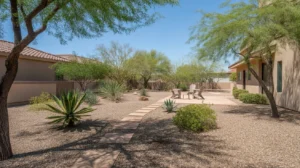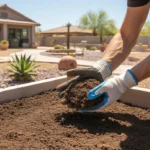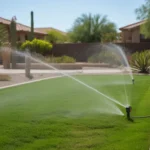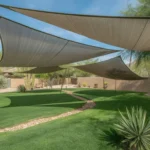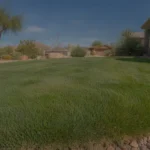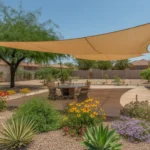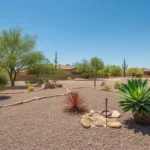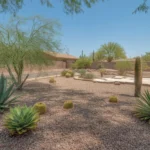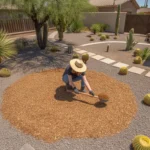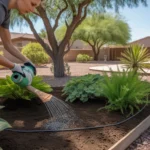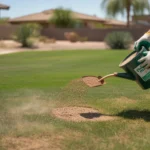As Queen Creek residents face the challenges of drought and water restrictions, many are rethinking the traditional grass lawn. While lush turf grass may be a suburban ideal, it’s often impractical and unsustainable in our desert climate. Fortunately, there are many attractive, low-water lawn alternatives that can help you create a beautiful and resilient yard while conserving our precious water resources. By embracing drought-tolerant landscaping, you can transform your Queen Creek yard into an oasis of rugged beauty and responsible stewardship.
Xeriscape Principles: Designing a Water-Wise Yard
Xeriscaping is a landscaping approach that prioritizes water conservation through careful design, plant selection, and efficient irrigation. By following xeriscape principles, you can create a yard that’s both beautiful and sustainable, even in Queen Creek’s arid climate.
The first step is to assess your yard’s unique conditions, including sun exposure, soil type, and natural drainage patterns. This will help you choose plants that are well-suited to your specific microclimate. Group plants with similar water needs together, and use mulch to retain moisture and suppress weeds.
When it comes to irrigation, opt for efficient systems like drip lines or soaker hoses that deliver water directly to plant roots. Install a smart controller that adjusts watering based on weather conditions, and consider harvesting rainwater or graywater to supplement your irrigation.
Drought-Tolerant Ground Covers: Lush Alternatives to Grass

If you’re looking to replace your thirsty lawn with a low-water alternative, consider planting drought-tolerant ground covers. These low-growing plants spread horizontally, creating a dense carpet of foliage that can mimic the look of a traditional lawn.
Some excellent options for Queen Creek include:
- Trailing Rosemary: This fragrant, evergreen ground cover has delicate blue flowers and can handle light foot traffic.
- Damianita: A tough, low-growing plant with bright yellow flowers that bloom from spring to fall.
- Creeping Thyme: A hardy, aromatic ground cover that forms a dense mat of tiny leaves and produces small pink or purple flowers.
- Dymondia: A silver-leaved ground cover that spreads slowly, making it ideal for small areas or between pavers.
When planting ground covers, be sure to space them properly to allow for mature growth. Most will take a season or two to fully fill in, but once established, they require little maintenance beyond occasional trimming and infrequent deep watering.
Hardscaping: Incorporating Permeable Pavers and Gravel
Another way to reduce your lawn footprint is to incorporate hardscaping elements like permeable pavers or gravel. These materials allow water to percolate into the soil, reducing runoff and helping to recharge groundwater.
Permeable pavers come in a variety of styles and colors, and can be used to create patios, walkways, or even driveways. Interspersed with drought-tolerant plants or ground covers, they can create an attractive, low-maintenance landscape that requires little to no irrigation.
Gravel is another versatile hardscaping material that can be used to create dry creek beds, borders, or seating areas. Choose a local, angular gravel that will lock together and resist shifting. Pair it with boulders, driftwood, or sculptural plants for a naturalistic look.
Native and Desert-Adapted Plants: Celebrating Queen Creek’s Natural Beauty
One of the best ways to create a drought-tolerant yard is to embrace native and desert-adapted plants. These tough, resilient species have evolved to thrive in our harsh climate, and many have beautiful foliage and flowers that can add color and texture to your landscape.
Some standout options for Queen Creek include:
- Desert Marigold: A cheery, yellow-flowered perennial that blooms from spring to fall and attracts pollinators.
- Penstemon: A genus of spiky, upright perennials with tubular flowers in shades of red, pink, or purple.
- Agave: A sculptural succulent with bold, fleshy leaves that can serve as a striking focal point.
- Palo Verde: A small, multi-trunked tree with green bark and brilliant yellow flowers that appear in spring.
When selecting native and desert-adapted plants, consider their mature size and growth habits to ensure they’ll fit well in your landscape. Group plants with similar water and sun requirements, and give them room to grow and showcase their natural forms.
Artificial Turf: A Low-Maintenance Alternative
For homeowners who love the look of a lush lawn but don’t want the water bills or maintenance hassles, artificial turf can be an attractive option. Today’s synthetic grass products are more realistic and durable than ever, and can be used to create a variety of spaces from play areas to putting greens.
When choosing artificial turf, look for products specifically designed for landscape use, with built-in drainage and heat-resistant fibers. Proper installation is key to ensuring a long-lasting, natural-looking result, so consider hiring a professional with experience in synthetic turf.
While artificial turf does require an upfront investment, it can pay off in the long run through reduced water, fertilizer, and maintenance costs. It’s also a great option for high-traffic areas or yards with heavy shade where grass struggles to grow.
Maintaining Your Drought-Tolerant Yard: Tips for Queen Creek Homeowners
While drought-tolerant landscaping requires less water and maintenance than a traditional lawn, it still needs some regular care to look its best. Here are a few tips for maintaining your low-water yard:
- Water deeply and infrequently: When you do water, give plants a deep soaking to encourage deep root growth. Then, let the soil dry out between waterings.
- Mulch regularly: A 3-4 inch layer of organic mulch will help retain moisture, moderate soil temperatures, and suppress weeds. Replenish as needed.
- Prune and trim: Regularly prune trees and shrubs to remove dead, damaged, or crossing branches. Trim ground covers and perennials after flowering to encourage fresh growth.
- Manage pests naturally: Avoid using broad-spectrum pesticides that can harm beneficial insects. Instead, use targeted, organic methods like neem oil or insecticidal soaps to manage pests.
By adopting these maintenance practices, you can keep your drought-tolerant yard looking lush and healthy while still saving water and time. As your landscape matures, it will become even more resilient and self-sustaining, providing beauty and enjoyment for years to come.
Transforming your Queen Creek yard into a drought-tolerant oasis is an investment in both your property and our shared environment. By embracing xeriscape principles, low-water ground covers, hardscaping, and native plants, you can create a landscape that celebrates the rugged beauty of the desert while conserving our most precious resource. With a little creativity and care, your yard can become a model of sustainable living and an inspiration to your neighbors and community.

